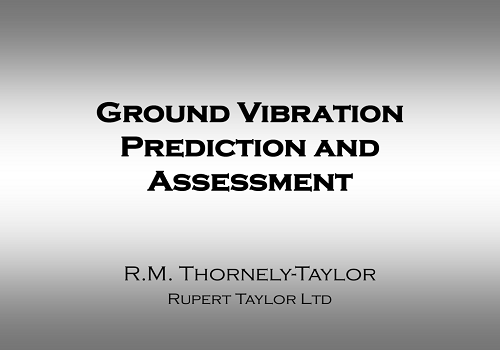Admin
مدير المنتدى


عدد المساهمات : 18996
التقييم : 35494
تاريخ التسجيل : 01/07/2009
الدولة : مصر
العمل : مدير منتدى هندسة الإنتاج والتصميم الميكانيكى
 |  موضوع: بحث بعنوان Ground Vibration Prediction and Assessment موضوع: بحث بعنوان Ground Vibration Prediction and Assessment  الخميس 22 يوليو 2021, 1:43 am الخميس 22 يوليو 2021, 1:43 am | |
| 
أخوانى فى الله
أحضرت لكم
بحث بعنوان
Ground Vibration Prediction and Assessment
R.M. Thornely-Taylor, Rupert Taylor Ltd

و المحتوى كما يلي :
INTRODUCTION
Vibration is often grouped with noise and regarded as a kindred topic. Noise, after all,
begins as vibration, and vibration is as much a part of acoustics as is noise.
By comparison, though, noise is simple. It always occurs in air, and except in special
circumstances (e.g. in reactive near fields) the characteristic impedance of air is more
or less always the same. So much so that we have standard methods of measuring
sound power based on the measurement of sound pressure. The biggest complexities
arise with velocity gradients in long distance propagation. Airborne sound almost
always propagates as a compression wave, and the speed of sound is about the
same at all frequencies. Damping due to air viscosity and boundary absorption is
reasonably well understood. Only at very high intensities does airborne sound
propagation become non-linear.
Vibration, by contrast, occurs in media ranging from rock or solid concrete, through
water and soil to lightweight panels. It can propagate as a compression wave, a shear
wave, a variety of surface waves, bending waves, torsional waves, either separately or
together. It can propagate in two different media at the same time (e.g. water
contained in porous rock and the rock itself). The propagation velocity of bending
waves is frequency dependent. Damping can occur either through viscosity, or
because of hysteresis or because of relaxation effects in solids and the mechanisms
are not all properly understood. Sources of vibration such as machinery out of
balance, moving loads and discontinuities are capable of moderately straig
mathematical description and manipulation. Transmission of vibration, and reception
at the point of interest is beset with complexities and uncertainties.
To minimise the uncertainties, much more detailed prediction and modelling methods
are required than is the case with airborne noise, and complex assessment methods
are required.
CONSIDERATIONS IN ASSESSMENT
Vibration affects people, structures and machines. The assessment of vibration
affecting the last class, vibration-sensitive machines, normally necessitates reference
to the manufacturers of the machines for sensitivity criteria. General criteria are
available in the literature [9]. The position is complicated by the fact that highly
sensitive machines tend to be installed with local vibration-isolating foundations.
As far as structures are concerned, damage to the fabric, for example in terms of
cracks, is the principal consideration and criteria appear in the literature [9][10].
The assessment of vibration affecting people is the most complex of the three
considerations. This is partly because most people’s normal environment involves
perception of vibration only in response to events such as footfalls and door slams,
and in transportation environments. Any vibration from an extraneous source, above
the threshold of perception, tends to give rise to indirect concerns about potential
building damage, even though it is well-established [9][10] that amplitudes of vibration
sufficient to cause even cosmetic cracks in buildings are many times higher than
perception thresholds. Vibration below the threshold of perception can affect people
through their sense of hearing if the vibration occurs at acoustic frequencies and is reradiated as airborne noise by building surfaces.
Discounting unfounded fears of building damage, assessing the direct effects of
vibration on people is made difficult by differences the standards that are in use. BS
6472 adopts weighting curves which differ from those in ISO 2631, and which are
under review [9][11][12]. However, most weighting curves have the effect that human
response is velocity-dependent above the region 8-10 Hz. The differences concern
absolute sensitivity and sensitivity at frequencies below this region. Reference to
figure 1 above shows that differences between the driving-point impedance of a
human body in the sub-10Hz region are so large that time spent attempting to refine
weighting curves in this region is somewhat futile given the large uncertainties which
exist according to weight and sex of the person concerned. In any event, use of
velocity is unlikely to underestimate human response.
The second matter relates to the effect of duration and number of vibration events. In
the UK, the vibration dose value, using the BS-specific Wg [11] weighting is used. This
takes the fourth root of the duration and/or the number of events for use in a linear
scale, which is therefore very insensitive to duration and number. VDV also appears in
ISO 2631 [12] but using a different weighting curve.
In the UK, current practice is to follow BS 6472, the use of which is clarified in
reference [9]. It is likely, however, to be several years before assessment of vibration
reaches the internationally accepted status that has broadly been achieved in noise assessment.
كلمة سر فك الضغط : books-world.net
The Unzip Password : books-world.net
أتمنى أن تستفيدوا من محتوى الموضوع وأن ينال إعجابكم
رابط من موقع عالم الكتب لتنزيل بحث بعنوان Ground Vibration Prediction and Assessment
رابط مباشر لتنزيل بحث بعنوان Ground Vibration Prediction and Assessment 
|
|







